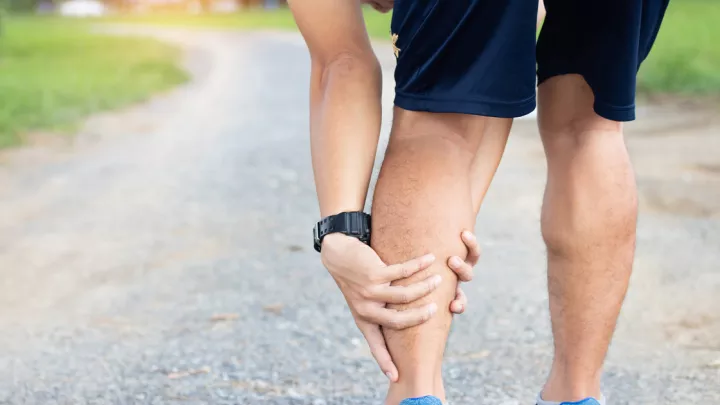Tennis elbow, ACL tear, sprained ankle and more: 6 common sports injuries and how to treat them

Summer brings warm weather, making it a great time for outdoor activities like running, swimming, golfing and playing team sports. The uptick in outdoor activities also makes summer the perfect storm for sports injuries.
Below, we discuss the following six common summer sports injuries:
- Tennis elbow
- Rotator cuff injuries
- UCL injuries
- ACL injuries
- Ankle injuries
- Hamstring, hip and thigh muscle injuries
Tennis elbow
A common injury during the spring and summer months is tennis elbow, also known as lateral epicondylitis. It typically occurs when repetitive motions — like those in tennis and other racquet sports, or even activities at home, such as yardwork and gardening — strain muscles in the forearm to the point of creating inflammation, or in some cases tiny tears in the tendons.
Tennis elbow symptoms:
- Pain near the outside of the elbow, especially when extending the wrist
- Decreased grip strength
Tennis elbow treatment options:
- Rest or decreased physical activity
- Ice
- Over-the-counter medicines or anti-inflammatory drugs like ibuprofen and aspirin
- A brace made for tennis elbow or lateral epicondylitis
- Physical therapy
- Steroid or cortisone injections
- Working with a professional to evaluate and assess body mechanics
Depending on the severity of your injury and your response to conservative treatments, you may need to consult with a physician to discuss other options like surgery.
Rotator cuff injuries
The rotator cuff is comprised of four muscles that work in part to help stabilize and control the motions of the shoulder during activity. Over time, rotator cuff tendons can rub against or impinge on a bone in the shoulder. This shoulder impingement can lead to rotator cuff tears or tendonitis. Repetitive overhead motions used in sports like tennis, swimming and baseball can also increase the risk of rotator cuff injuries. Additionally, muscular imbalances and weakness in the back and shoulder blade area can contribute to rotator cuff injuries.
Rotator cuff injury symptoms:
- Pain and weakness, particularly when raising the arm forward, overhead or out to the side, or at night
- Decreased range of motion
- Dull, aching pain that radiates down the arm
- Loss of strength or endurance during physical activity
- Loss of velocity, speed or control
Rotator cuff treatment options:
- Rest
- Activity modifications, such as adjusting practice intensity
- Anti-inflammatory drugs like ibuprofen and aspirin
- Physical therapy
- Steroid or cortisone injections
Depending on your age, activity level and severity of injury, surgery may be recommended.
Ulnar collateral ligament (UCL) injuries of the elbow
The ulnar collateral ligament is the ligament on the inside of the elbow that helps stabilize the elbow. Injuries to the ligament can vary from minor stretching to a partial or complete tear. In young athletes, UCL injuries typically occur because of overuse or repeated trauma and are often associated with overhead motions like throwing. A UCL injury can also occur after falling on an outstretched arm or because of an elbow dislocation.
UCL injury symptoms:
- Pain or pop at the time of injury
- Tenderness on the inside of the elbow, particularly during or after throwing
- Neurological symptoms, such as numbness or difficulty moving the pinky finger
UCL injury treatment options:
- Rest
- Anti-inflammatory drugs like ibuprofen and aspirin
- Physical therapy
- Working with coaches and trainers to ensure proper form and mechanics
Surgery may be recommended for individuals that do not respond to conservative care or for athletes returning to a high level of physical activity. The most common type of surgery is UCL reconstruction, otherwise known as Tommy John surgery.
Anterior cruciate ligament (ACL) injuries
When it comes to knee injuries, sprained or torn anterior cruciate ligaments are very common – and they are the ones we most often hear about because they are typically associated with surgery and extensive recovery. The ACL is a strong band of tissue that connects the thighbone to the shinbone and helps stabilize the knee. When a person lands incorrectly or changes direction suddenly, it can put pressure on the ACL and cause the ligament to tear or rupture. But sports mishaps aren't the only things that lead to these types of injuries – unintentional falls or blows to the knee can also cause them.
ACL injury symptoms:
- Pain or an audible pop at the time of injury
- Sensation of the knee "shifting" at the time of injury
- Swelling of the knee
- Feeling of instability
- Inability to bear weight due to pain or instability
ACL injury treatment options:
For injuries that are not complete ruptures, options may include:
- Physical therapy
- Anti-inflammatory drugs like ibuprofen and aspirin
- Knee brace
Many people – especially athletes – may find that surgery is the best option depending on their age, level of physical activity and degree of instability.
Ankle injuries
Foot and ankle injuries can range from tendonous injuries to sprains to fractures. Lateral ankle sprains are the most common and can range from grade 1 (stretch) to grade 3 (complete tear). The most common injuries tend to be noncontact, often due to a misstep, fall, or an awkward landing after jumping. However, direct impacts from forces like crashes or dropped objects can also cause ankle injuries. Balance training, strengthening exercises and taping can help stabilize the ankle to prevent injury.
Ankle injury symptoms:
- Pain, localized or in a general area, especially when walking or standing
- Persistent swelling (usually on the outside of the ankle but may be the whole ankle)
- Loss of function, range of motion or balance issues
- Inability to bear weight or walk on the foot/ankle
Ankle injury treatment options:
- Rest
- Ice
- Compression or an ACE™ wrap
- Walking boot or crutches, particularly for those unable to walk without pain or limping
- Anti-inflammatory drugs like ibuprofen and aspirin
- Physical therapy
- Balance exercises and activities to strengthen the foot and ankle
Depending on the severity of the injury, surgery may be recommended.
Hamstring, hip and thigh muscle injuries
Hamstring, hip and thigh muscle injuries are also common during summer months. Like other sports injuries, these conditions can range in severity from stretching of the muscle to a partial tear or complete rupture.
Most often, these muscles are injured because of one or a combination of the following:
- Fatigue
- Overload
- Overstretching
- Muscular imbalance
- Not warming up properly
- Reinjury or returning to play too soon after an injury
Hamstring, hip and thigh muscle injury symptoms:
- Pain in the back of the leg or up near the glutes where the hamstrings attach
- A pop at the time of impact
- A knot in the back of the leg or a hole if the muscle is torn
- Bruising in the back of the leg or behind the knee
- Weakness
- A cramping sensation
- Swelling that doesn't go away
Hamstring, hip and thigh muscle injury treatment options:
- Rest
- Ice
- ACE™ wrap or neoprene thigh sleeve
- Anti-inflammatory drugs or pain medication like ibuprofen and aspirin
- Physical therapy
Proper body mechanics and technique are key to preventing sports injuries. When an injury does occur, it's important to seek treatment promptly to avoid permanent damage or loss of function. A doctor can perform a physical examination and may order additional tests, such as X-rays or an MRI, to help identify the best course of care. If you experience any of the symptoms above, don't wait. Reach out to us for an expert consult and recommendation.
"It's good to have a team of professionals involved in care following an orthopaedic injury, especially as one works back into a sport," says Rusty McKune, ATC, ambulatory supervisor for the Nebraska Medicine Sports Medicine Program. "It's easy to overdo it and returning to activity should be a gradual process that allows the body to accommodate to the demands that are going to be placed on it."







